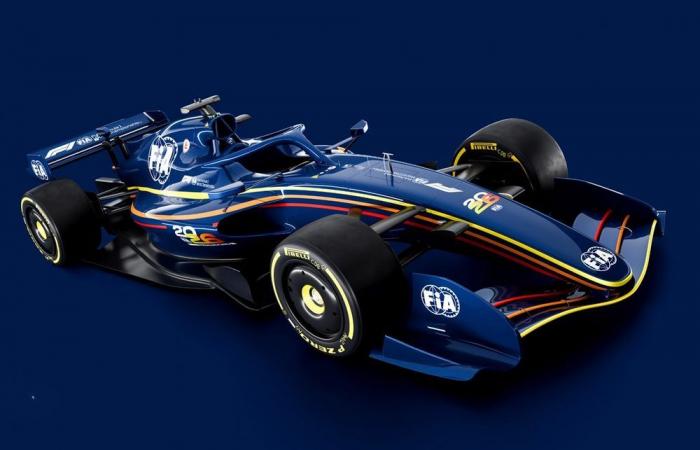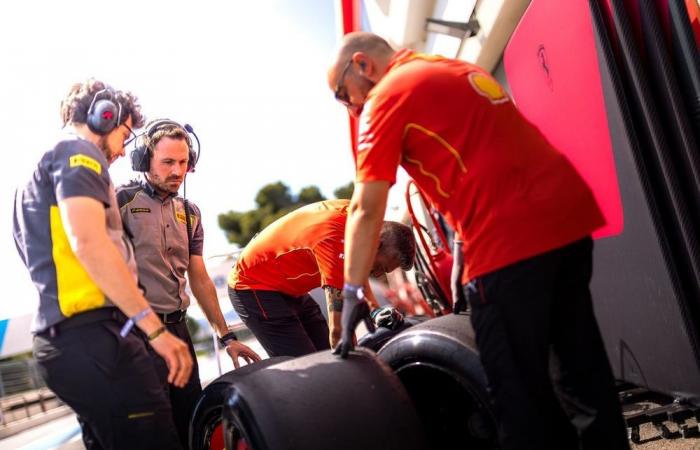With the objective of make F1 cars smaller and less heavy, Pirelli agreed to reduce the width of the front tires by 25 mm and the rear tires by 30 mm. The diameter of the compounds will also be reduced, which will go from the current 720 mm to 705-710 mm, despite continuing to use 18-inch wheels.
In spite of the reduction in tire sizethe FIA does not expect the new Pirelli tires to have significantly lower grip compared to the current ones.
“We don’t expect a significant difference from the changes that are being made to the tires with respect to overall mechanical grip,” said FIA single-seater technical director, Jan Monchaux. “There may be a slight reduction because the tires are smaller, but it’s not a difference that really worries us.”
There had been talk of further reducing tire and rim size, with a move to 16-inchers on the table. But the FIA and Pirelli said it would not be right to add another variable to what is already a complex set of technical changes.
“We don’t want the tires to be a source of concern anymore in 2026, and with these new engines, which in the traction phase will have an enormous amount of power, we were just a little nervous about changing to much smaller ones,” explained Monchaux.
“The reduction in tires is less than we would have all expected, but we did not want to have too big a difference compared to the product we already know and that we now have,” he said.
Mario Isola, racing director of Pirelli Motorsport, at the team directors’ press conference.
Photo: Zak Mauger / Motorsport Images
Pirelli’s motorsports director, Mario Isolasaid that keeping the 18-inch tires would give the Italian manufacturer a better chance to deal with overheating of the tires, a criticism that their current Formula 1 compounds have faced.
“We proposed the narrower 18-inch tire to save some weight. In our opinion, it is a good compromise between weight savings and a rubber that has characteristics that will be needed in 2026.”
“With the 16-inch tires, we were concerned about the load capacity of the tire, as well as the possibility of significantly increasing overheating. We did some simulations and made a proposal to continue with 18-inch tires, which was accepted,” added the Italian. .
The weight saved with these smaller tires should mean four or five kgnumbers that are part of the FIA’s ambitious goal of reducing the weight of the car by 30 kg.
The FIA single-seater director, Nikolas Tombazis, assured that Pirelli will be granted “greater opportunities” to carry out tests for 2026. The biggest obstacle for the Italian supplier, however, is the absence of a mule car that is truly representative.
Pirelli hopes to have physical prototypes for this year’s tests in September, but they will be cars from the current era with low downforce, but they will still be very different from those of 2026 and do not have the active aerodynamics that future cars will have.
“We will have mule cars, but they will be bigger, heavier, without active aerodynamics and with downforce that comes from a different concept.”
“Testing our narrow tires on these cars gives us the chance to collect data, but then we have to cross-check it with the simulations to know if we are going in the right direction. We can’t just rely on track testing.”
“We had a similar situation in 2016, because in 2017 the cars were five or six seconds per lap faster than the previous year. We are going to test with a downforce configuration that we believe simulates what 2026 is going to be, but the problem is that we will have more aerodynamic resistance. We don’t have a 2026 car and that complicates everything,” Isola added.
FIA 2026 F1 sketches
Photo by: FIA
Having access to data from all 10 teams should help Pirelli stay on track, but if it needs to make further adjustments it can play with the range of compounds available later.
For next year, Pirelli is working on a sixth, softer compound, which should be more suitable for lower-load street circuits, and could maintain that wider range in 2026.
“We can correct or tune with a different range of compounds,” Isola said. “So we can go softer, for example, if the load level is lower compared to now. It is always a balance that we have to find when we know the characteristics of the new car.”
Given the the final regulation of 2026 has not yet been signed and that Pirelli’s tire constructions must be completed by September 1, 2025, the Italian brand will have about 12 months to complete its development. Although it is an aggressive deadline, Isola is confident that Pirelli can move the project forward.
“It’s not something new, honestly. The same thing happened with the other big regulation changes we had; we do everything we can to make the best tire for the future, as we already did.”
“There are some limitations, we accept that, but we work to the best of our ability to supply tires with the required characteristics. If they are not perfect the first year, we will work to adjust them or tune them for the following year, as we always do.
“But that is also the same when the regulations do not change, because in any case the teams are developing the cars, and we have to follow them with our tires,” he concluded.

Members of the Pirelli and Ferrari teams
Photo by: Pirelli
Do you want to read our news before anyone else and for free? Follow us here on our Telegram channel and you won’t miss anything. All the information, at your fingertips!







